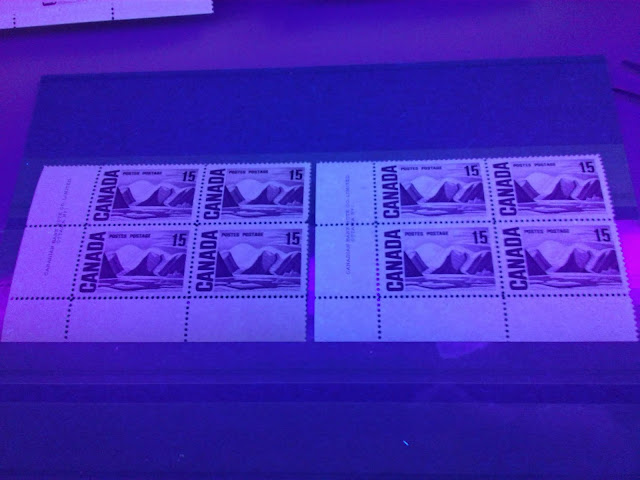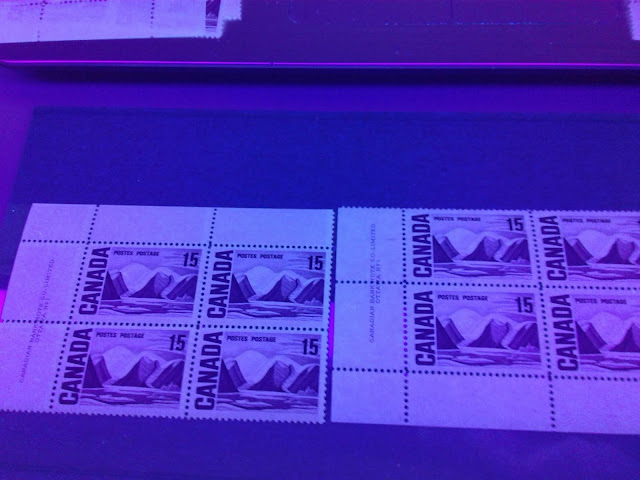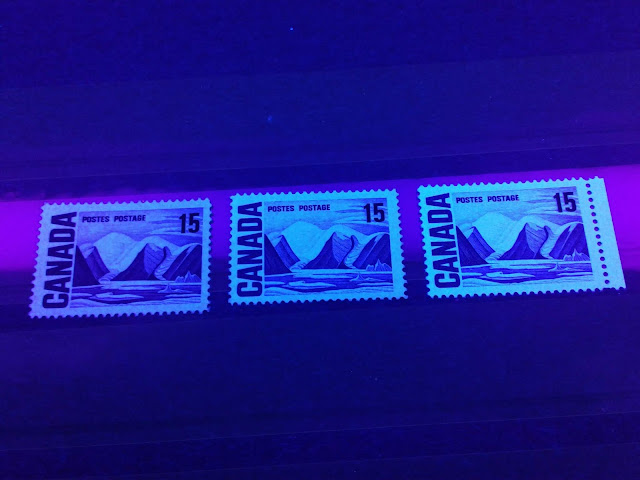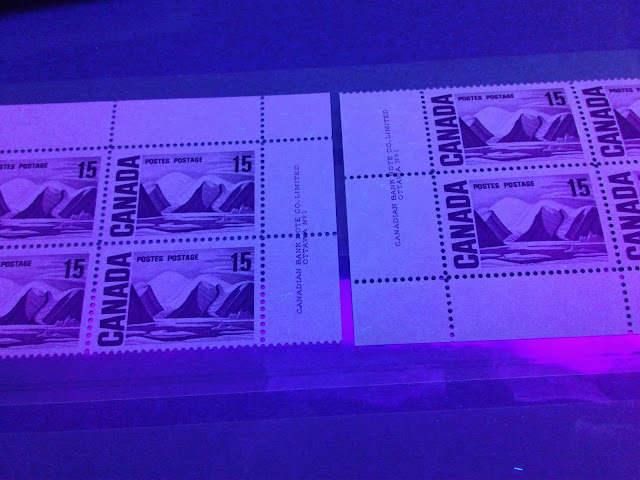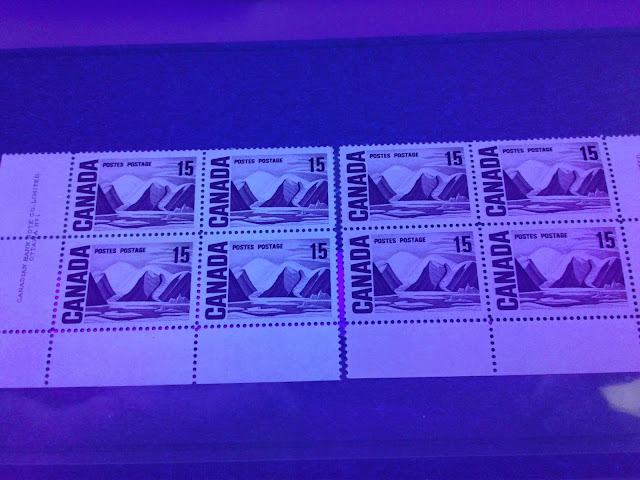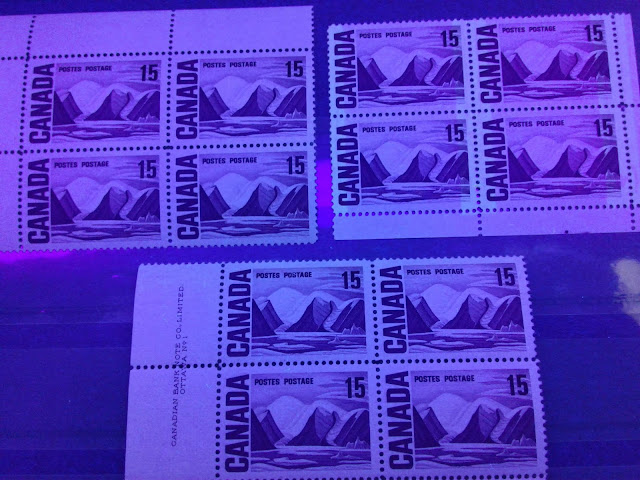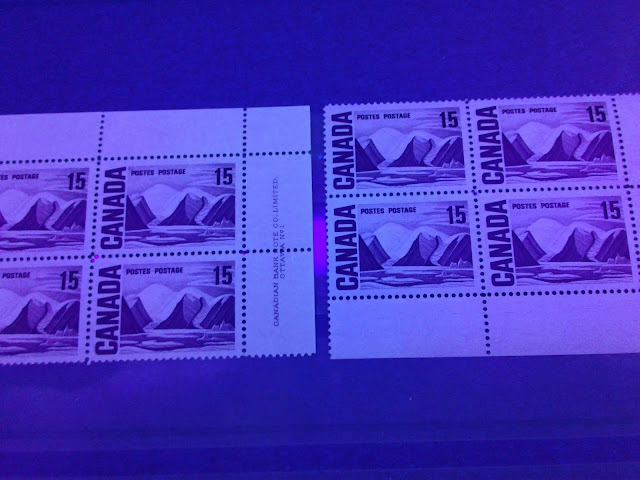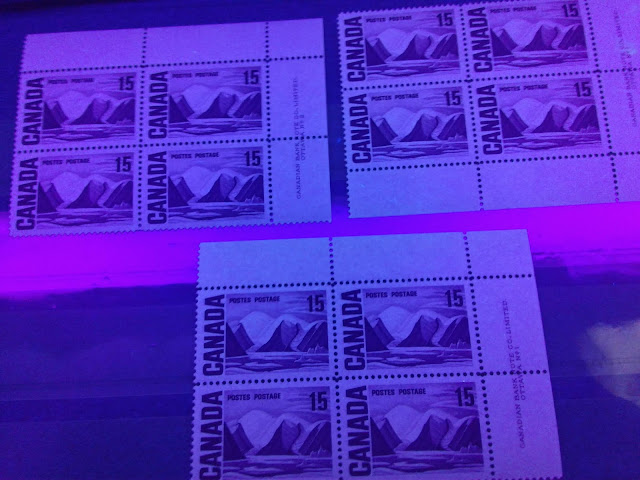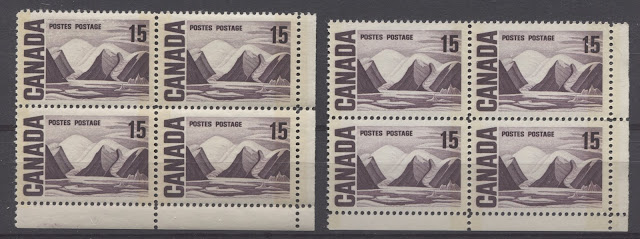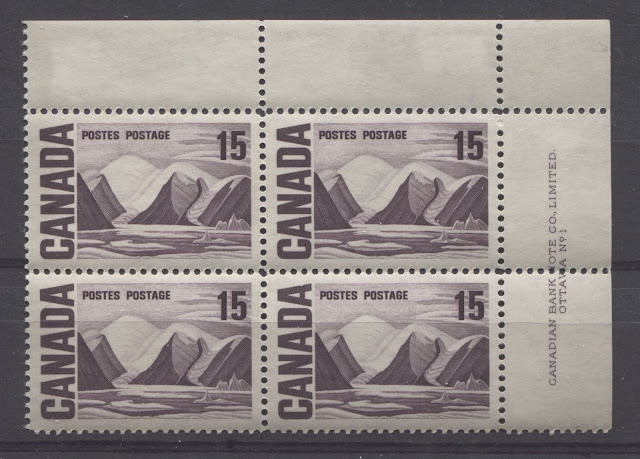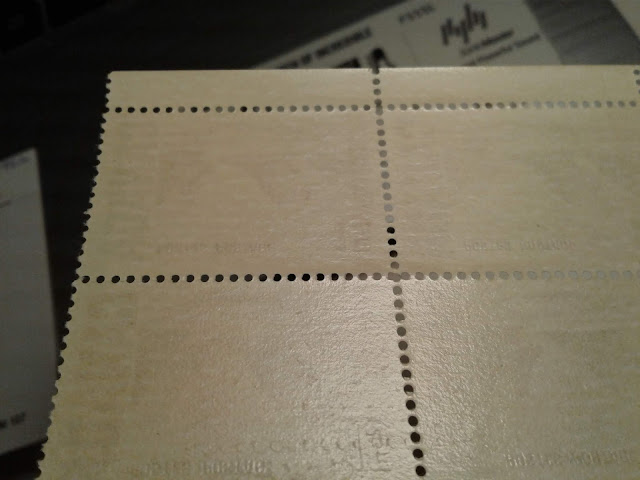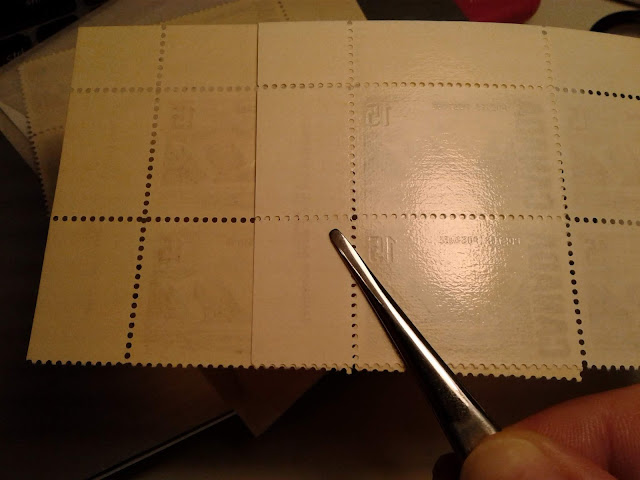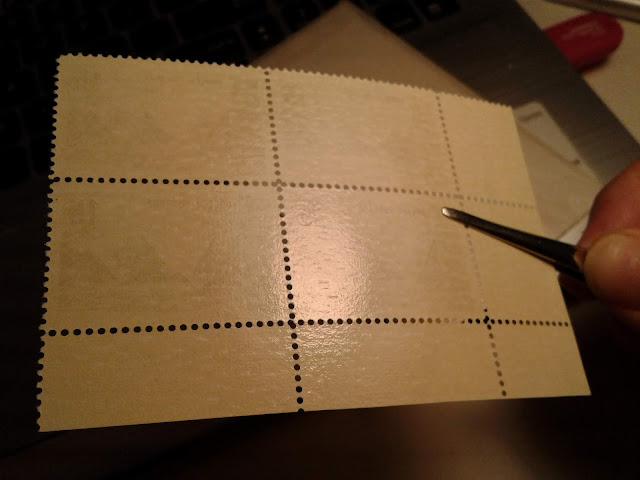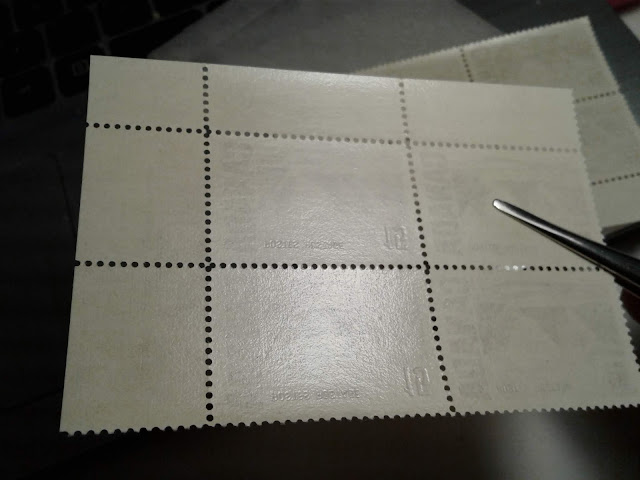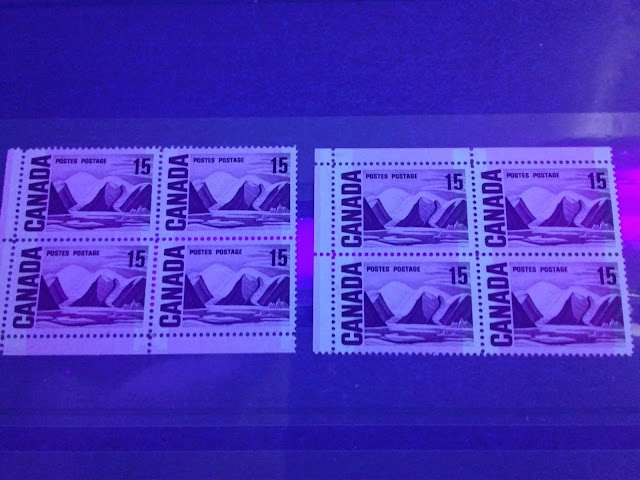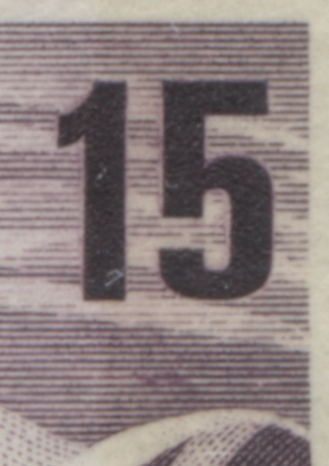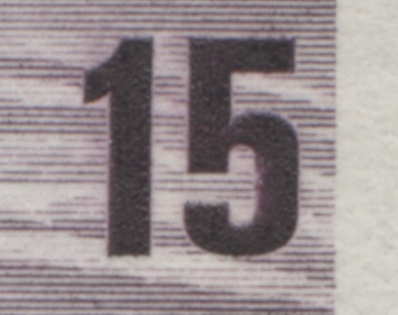Today's post tackles the third high value in the Centennial series: the 15c Bylot Island, by Lawren Harris. Bylot island is in part of what used to be the Northwest Territories and is now Nunavut. Next to the 10c this was the second most heavily printed high value. The reason is because the foreign airmail rate to Europe was 15c during the life of this issue. So, the vast majority of covers to those destinations would have had the postage paid by a single 15c stamp. The demand for these stamps would have led to many printings, and of course a very delightful array of collectible varieties, including many rare plastic flow varieties that are now listed in Unitrade.
In keeping with the method I followed in dealing with the 10c value, I am going to separate these by gum type and then cover this value in two posts: one for the dextrose gum stamps, and one for the PVA gum stamps. Today's post will look at those stamps issued with Dextrose gum.
Unitrade lists five varieties for the untagged dextrose gum stamps, which were issued from February 8, 1967 until the stamps with PVA gum began to replace them in February 1972:
The LF-fl paper is shown on the right, while the typical DF paper is shown on the left. As you can see, there is quite a difference between the two. Once you have seen what the true LF-fl paper looks like, you will generally be able to pick it out from a lot of plate blocks, without having to make comparisons like this.
I have found three different types of the LF-fl paper as shown by the pictures below:
The first type of paper, shown in the block on the left is a dull fluorescent brownish grey paper that contains a very sparse concentration of low and medium fluorescent fibres, as well as very few high fluorescent fibres. The second paper type is shown on the block at right. This block is on a dull fluorescent greyish white paper that contains a higher concentration of fibres: sparse low and medium fluorescent, very sparse high fluorescent and 1-2 hibrite fibres.
This type of paper is shown on the right of the next picture, along with the third type of low fluorescent paper:
The third type of paper appears dull fluorescent yellowish grey under UV, and contains very few low fluorescent, medium fluorescent, high fluorescent and hibrite fibres.
Hibrite Papers
As is the case with many of the so called hibrite papers on this issue, there are actually three grades of fluorescence that ranges from medium fluorescent to hibrite. None of the papers are flecked, but the medium fluorescent certainly appears hibrite when compared to the dull and low fluorescent papers.
The picture below shows all three of these levels of fluorescence:
In studying this stamp, I have identified no fewer than fifteen variations of the dull fluorescent paper. These papers generally vary according to their colour under UV light, as well as whether or not they contain any fluorescent fibres, and if so, how many and how bright those fibres are. In all cases, the overall fluorescence level will still appear dull.
The first two of these papers are shown below. They are both variations of grey under UV and both are flecked papers:
The block on the left is a dull fluorescent grey under UV, and contains very few low, medium and high fluorescent fibres. The block on the right is printed on a paper appearing dull fluorescent brownish grey, and containing 1-2 medium and high fluorescent fibres on each stamp. I have found that the tagged stamps can be found on this paper.
The next three blocks, and paper types are all variations of dull fluorescent yellowish grey. They vary only in terms of the concentration and brightness of the fluorescent fibres contained in the paper:
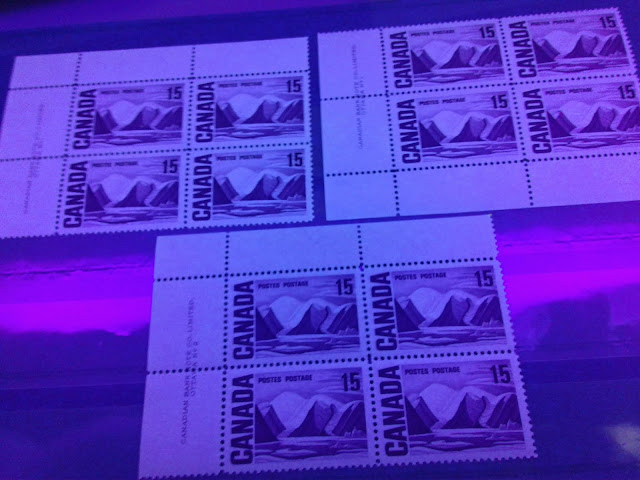
The block on the top left contains very few low fluorescent, medium fluorescent and high fluorescent fibres, as well as 1-2 hibrite fibres per stamp. The block at top right contains very few low and medium fluorescent fibres and 1-2 high fluorescent ones. Finally, the bottom block contains no fluorescent fibres at all. I have not, as yet, found any tagged stamps on these papers.
The next two non-flecked papers show the dramatic colour differences that can be seen on dull fluorescent paper:
On the left is the dull fluorescent ivory paper, while on the right is the dull fluorescent light brown paper. It appears slightly violet in the picture, but in reality it is a definite brown. The ivory paper looks much brighter than the light brown paper, and almost looks low fluorescent by comparison. However, if you view the ivory paper on its own, it still appears dull under UV light, and especially so, when placed next to a true LF-fl paper. I have not found tagged examples on either type of paper.
The next group of papers are what I would call an ivory grey colour under UV. Again, the group contains flecked and non-flecked variations, and is the only other group that I have identified that exists with the Winnipeg tagging:
The block at the top left contains no fluorescent fibres at all. The tagged block at upper right contains very few low, medium and high fluorescent fibres, as well as 1-2 hibrite fibres. The block on the bottom row contains 1-3 each of low fluorescent, medium fluorescent and high fluorescent.
The next two papers are non-flecked papers, and are brownish grey and greyish white:
The brownish grey paper is shown by the block on the left, while the block on the right is dull fluorescent greyish white.
The last three blocks are different colours under UV light, with the colours being yellowish grey, grey and violet grey:
Here we have the yellowish cream gum with the satin sheen.
Here we see a yellowish cream gum on the left block, and the cream coloured semi-gloss gum that was shown above on the right. As you can see there is a distinct colour difference between both types of gum.
Here is the streaky yellowish cream gum. The streakiness comes from a regular pattern of horizontal blemishes in the gum.
In keeping with the method I followed in dealing with the 10c value, I am going to separate these by gum type and then cover this value in two posts: one for the dextrose gum stamps, and one for the PVA gum stamps. Today's post will look at those stamps issued with Dextrose gum.
Unitrade lists five varieties for the untagged dextrose gum stamps, which were issued from February 8, 1967 until the stamps with PVA gum began to replace them in February 1972:
- Dull fluorescent paper.
- Low fluorescent paper
- Hibrite paper.
- Plastic flow variety on dull fluorescent paper.
- Plastic flow variety on hibrite paper.
As we shall see, the listings are lacking because in addition to the usual shade, gum and perforation differences that Unitrade ignores, there are also variations of each major paper fluorescence level, and the plastic flow variety exists on every type of paper as it is a constant variety. So, while Unitrade only lists it in Dull fluorescent and hibrite paper, it also exists on low fluorescent paper as well.
The tagged stamps with dextrose gum only exist with Winnipeg tagging, which Unitrade lists as 463p, and these stamps exist with the plastic flow variety naturally as well. These are listed as #463pvii.
The remainder of this post will examine the attributes and variations therein for the printings made with dextrose gum.
Paper Attributes Other Than Fluorescence
In addition to fluorescence, the paper used for this issue varies in other attributes as well. I have found the following types of paper on this value:
- A horizontal, cream coloured wove paper that has a burnished smooth appearance on the printing surface. Under magnification, a very light coating can be seen on the surface, which prevents any fibres from coming loose. No ribbing is visible on either the front or back of this paper and when held up to a strong back light, vertical mesh can be seen in the paper.
- A cream wove paper that is similar to above, but is vertical, rather than horizontal wove. The vertical mesh pattern in this paper is visible when viewed against back lighting, but is not as prominent. Horizontal mesh is also visible. The vertical mesh is actually more prominent on this paper when it is viewed from the back face-down on a dark surface.
- A horizontal cream wove that looks very similar to (1) above, except that when held up and viewed against strong back lighting, only horizontal mesh is prominent, but if you look closely, you can see that the mesh is both horizontal and vertical.
- A vertical cream wove that appears noticeably whiter compared to the other cream papers. The mesh of this paper is visible on the back through the gum as light ribbing. When viewed against strong back light, this paper shows a strong vertical and horizontal mesh pattern in which the vertical mesh dominates.
It is not clear whether these paper types correspond to particular levels of fluorescence, but it does appear as though each of these paper types do correspond to a particular fluorescence level described below. So I do not think that each fluorescence level necessarily exists on all four types of paper. A full scale study of paper would be required to settle this fully, which I have not done here.
Paper Fluorescence
Unitrade lists three grades of fluorescence on these stamps: dull fluorescent, low fluorescent and hibrite. However, as usual, there are several variations of each fluorescence level.
Low Fluorescent Papers
Identifying the low fluorescent paper can be confusing because the true low fluorescent paper is a flecked paper that contains fluorescent fibres, and the Unitrade catalogue does not mention this, calling the paper just LF. Also, there are dull fluorescent papers that contain some fluorescent fibres and still appear dull overall, as we shall see. The basic test is whether or not the paper on its own appears low fluorescent. The picture below shows the contrast between a typical LF-fl block and a block on DF paper:
The LF-fl paper is shown on the right, while the typical DF paper is shown on the left. As you can see, there is quite a difference between the two. Once you have seen what the true LF-fl paper looks like, you will generally be able to pick it out from a lot of plate blocks, without having to make comparisons like this.
I have found three different types of the LF-fl paper as shown by the pictures below:
The first type of paper, shown in the block on the left is a dull fluorescent brownish grey paper that contains a very sparse concentration of low and medium fluorescent fibres, as well as very few high fluorescent fibres. The second paper type is shown on the block at right. This block is on a dull fluorescent greyish white paper that contains a higher concentration of fibres: sparse low and medium fluorescent, very sparse high fluorescent and 1-2 hibrite fibres.
This type of paper is shown on the right of the next picture, along with the third type of low fluorescent paper:
The third type of paper appears dull fluorescent yellowish grey under UV, and contains very few low fluorescent, medium fluorescent, high fluorescent and hibrite fibres.
Hibrite Papers
As is the case with many of the so called hibrite papers on this issue, there are actually three grades of fluorescence that ranges from medium fluorescent to hibrite. None of the papers are flecked, but the medium fluorescent certainly appears hibrite when compared to the dull and low fluorescent papers.
The picture below shows all three of these levels of fluorescence:
The stamp on the left is medium fluorescent, the middle stamp is high fluorescent and the right stamp is hibrite. As you can see, while the difference between the left and centre stamps is small, there is a significant difference between the left and right stamps.
Dull Fluorescent PapersIn studying this stamp, I have identified no fewer than fifteen variations of the dull fluorescent paper. These papers generally vary according to their colour under UV light, as well as whether or not they contain any fluorescent fibres, and if so, how many and how bright those fibres are. In all cases, the overall fluorescence level will still appear dull.
The first two of these papers are shown below. They are both variations of grey under UV and both are flecked papers:
The block on the left is a dull fluorescent grey under UV, and contains very few low, medium and high fluorescent fibres. The block on the right is printed on a paper appearing dull fluorescent brownish grey, and containing 1-2 medium and high fluorescent fibres on each stamp. I have found that the tagged stamps can be found on this paper.
The next three blocks, and paper types are all variations of dull fluorescent yellowish grey. They vary only in terms of the concentration and brightness of the fluorescent fibres contained in the paper:

The block on the top left contains very few low fluorescent, medium fluorescent and high fluorescent fibres, as well as 1-2 hibrite fibres per stamp. The block at top right contains very few low and medium fluorescent fibres and 1-2 high fluorescent ones. Finally, the bottom block contains no fluorescent fibres at all. I have not, as yet, found any tagged stamps on these papers.
The next two non-flecked papers show the dramatic colour differences that can be seen on dull fluorescent paper:
On the left is the dull fluorescent ivory paper, while on the right is the dull fluorescent light brown paper. It appears slightly violet in the picture, but in reality it is a definite brown. The ivory paper looks much brighter than the light brown paper, and almost looks low fluorescent by comparison. However, if you view the ivory paper on its own, it still appears dull under UV light, and especially so, when placed next to a true LF-fl paper. I have not found tagged examples on either type of paper.
The next group of papers are what I would call an ivory grey colour under UV. Again, the group contains flecked and non-flecked variations, and is the only other group that I have identified that exists with the Winnipeg tagging:
The block at the top left contains no fluorescent fibres at all. The tagged block at upper right contains very few low, medium and high fluorescent fibres, as well as 1-2 hibrite fibres. The block on the bottom row contains 1-3 each of low fluorescent, medium fluorescent and high fluorescent.
The next two papers are non-flecked papers, and are brownish grey and greyish white:
The brownish grey paper is shown by the block on the left, while the block on the right is dull fluorescent greyish white.
The last three blocks are different colours under UV light, with the colours being yellowish grey, grey and violet grey:
The top block on the left is yellowish grey that contains 1-2 low fluorescent fibres only. The block at the top right is grey under UV and contains very few low, medium and high fluorescent fibres. Finally, the block on the bottom is violet grey under UV light, and contains very few medium and high fluorescent fibres, as well as 1-2 hibrite fibres.
Shades
There appear to be two major shades associated with the dextrose gum printings. Unitrade refers to the shade as dull purple, but in reality there are at least two shades. In terms of the Stanley Gibbons colour key they are:
- Blackish purple, and
- Deep rose lilac.
The two shades are very similar, but deep rose lilac is slightly brighter and contains a reddish undertone, whereas blackish purple does not.
The scan below shows the difference between these two shades:
Blackish purple is on the left and the deep rose lilac is on the right. The differences are most noticeable on the mountains and on the letters of "Canada". As you can see, the blackish purple is a much duller shade, and both of these are much deeper and duller than the shades encountered on the PVA gum stamps.
In addition to these two major shades there are some subtle variations as well:
1. A duller version of the deep rose lilac, which I call deep dull rose lilac.
2. Deep reddish lilac, which is a deeper, less rosy shade than the deep rose lilac.
These shades are shown in the scans that follow:
This is the deep dull rose lilac.
This is the deep reddish lilac. If you carefully compare this scan with the one above, you should be able to see that this colour is deeper and not dull.
This is pretty much all there is for shades on the stamps with dextrose gum. Under UV, the colours appear almost black, but you can still recognize them as dark shades of purple. For this reason, I believe the inks to be non-transformative on this value. The only exception is the stamps on hibrite paper, which do appear to be printed in black ink when viewed under UV.
Gum
Several types of dextrose gum can be found on these stamps:
- A smooth yellowish cream gum that has a semi-gloss sheen.
- A smooth yellowish cream gum that has a satin sheen.
- A smooth cream gum with a semi-gloss sheen.
- A smooth cream gum with a satin sheen.
- A streaky yellowish cream gum with a semi-gloss sheen.
The pictures below show the various types of gum:
Here we have the yellowish cream gum with the satin sheen.
Here we have a cream coloured gum with a semi-gloss to glossy sheen.
Here we see a yellowish cream gum on the left block, and the cream coloured semi-gloss gum that was shown above on the right. As you can see there is a distinct colour difference between both types of gum.
Here is the streaky yellowish cream gum. The streakiness comes from a regular pattern of horizontal blemishes in the gum.
The cream coloured gum with a satin sheen is shown above.
Perforation
As with all of the values of this set printed by the Canadian Bank Note Company, these stamps are line perf 11.95, 11.85 and compounds of these two perforations: 11.95 x 11.85 and 11.85 x 11.95.
Tagging
On December 9, 1969, the post office issued quantities of these stamps with Winnipeg 2 bar tagging. The configuration and application of the tagging bars was the same for these stamps as the 10c stamp and the other high value stamps: 8.5 mm bars with narrower spacing between the bars on the outside columns of the sheet and the inside columns. The tagging bars were applied first to the top panes in the printing layout and then to the bottom panes in two operations, so that there is a narrow gap between the tagging bars where the top panes are separated by selvage from the bottom ones. Therefore, you will generally see these gaps in the selvage of lower corner block positions in the top panes and upper positions in the bottom panes.
In normal light the tagging generally appears light yellow, with the bars occasionally appearing slightly darker. Under UV, I have seen two very slight differences in colour, with some having tagging bars that appear almost bluish white and others that appear yellowish white. Examples of both types are shown in the scan below:
The bluish white tagging is shown on the left, while the more yellowish white tagging is shown on the right.
The Plastic Flow Variety
This value in the series is the second one to exhibit what is known to collectors as a plastic flow variety. It manifests as a doubling of the "15" at the top right corner. The doubling itself consists of an outline on the left edges of the numerals, and to a lesser extent on the right edges as well. Below is a high resolution scan of what this variety looks like:
If you look to the left of the upper stroke of the"1", and the left side of the upper stroke of the "5" and along the inside of the "5" you will see a faint vertical line. This is not present on the normal stamps, which look like this instead:
See how there is no trace of these additional vertical lines? The difference is very obvious once you have seen it.
Bringing It All Together
The dextrose gum printings were printed from plates 1 and 2, while the tagged stamps were issued on field stock only. For the untagged stamps I have found:
- 21 paper types.
- 4 shades.
- 5 gum types.
- 4 different perforations.
- Plastic flow and normal types.
So, this means that the number of collectible single stamps can be as many as: 21 x 4 x 5 x 4 x 2 = 3,360 collectible stamps! That is an absolutely staggering number of potential variations. The number of possible blank corner blocks is therefore 3,360 x 12 = 40,320 blank corner blocks. Finally, the number of plate blocks is a little more complicated, as they do not exist on the HB paper. The number of possible plate blocks is : (3,360 x 8) - (480 x 8) = 23,040! So there is a phenomenal amount of scope to this stamp. If you find the dull papers too complicated or too similar to one another, then you still have at least 4 x 4 x 5 x 4 x 2 = 640 varieties of the basic stamps, and many more blocks and plate blocks.
For the tagged stamps, there are no plate blocks. However there are still at least 2 different paper types, 4 shades, 5 gum types, 4 perforations, plastic flow and normal varieties, and 2 different tagging types. This means that there are as many as 2 x 4 x 5 x 4 x 2 x 2 = 1,280 collectible stamps and 1,280 x 12 = 15,360 collectible corner blocks.
For the tagged stamps, there are no plate blocks. However there are still at least 2 different paper types, 4 shades, 5 gum types, 4 perforations, plastic flow and normal varieties, and 2 different tagging types. This means that there are as many as 2 x 4 x 5 x 4 x 2 x 2 = 1,280 collectible stamps and 1,280 x 12 = 15,360 collectible corner blocks.
This concludes my post about the dextrose gum printings of this stamp. Next week I will tackle the PVA gum printings.


